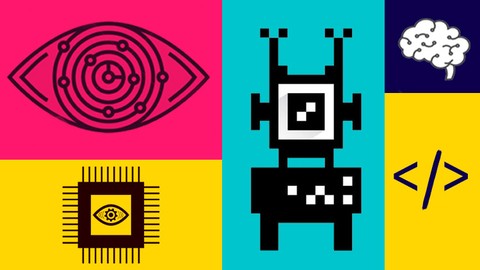
Master Computer Vision™ OpenCV4 in Python with Deep Learning
Master Computer Vision™ OpenCV4 in Python with Deep Learning, available at $74.99, has an average rating of 4.15, with 117 lectures, based on 3633 reviews, and has 21478 subscribers.
You will learn about Understand and use OpenCV4 in Python How to use Deep Learning using Keras & TensorFlow in Python Create Face Detectors & Recognizers and create your own advanced face swaps using DLIB Object Detection, Tracking and Motion Analysis Create Augmented Reality Apps Programming skills such as basic Python and Numpy How to use Computer Vision in executing cool startup ideas Understand Neural and Convolutional Neural Networks Learn to build simple Image Classifiers in Python Learn to build an OCR Reader for Credit Cards Learn to Perform Neural Style Transfer Using OpenCV Learn how to do Multi Object Detection in OpenCV (up to 90 Objects!) using SSDs (Single Shot Detector) Learn how to convert black and white Images to color using Caffe Learn to build an Automatic Number (License) Plate Recognition (ALPR) Learn the Basics of Computer Vision and Image Processing This course is ideal for individuals who are Beginners who have an interest in computer vision or College students looking to get a head start before starting computer vision research or Anyone curious using Deep Learning for Computer Vision or Entrepreneurs looking to implement computer vision startup ideas or Hobbyists wanting to make a cool computer vision prototype or Software Developers and Engineers wanting to develop a computer vision skillset It is particularly useful for Beginners who have an interest in computer vision or College students looking to get a head start before starting computer vision research or Anyone curious using Deep Learning for Computer Vision or Entrepreneurs looking to implement computer vision startup ideas or Hobbyists wanting to make a cool computer vision prototype or Software Developers and Engineers wanting to develop a computer vision skillset.
Enroll now: Master Computer Vision™ OpenCV4 in Python with Deep Learning
Summary
Title: Master Computer Vision™ OpenCV4 in Python with Deep Learning
Price: $74.99
Average Rating: 4.15
Number of Lectures: 117
Number of Published Lectures: 116
Number of Curriculum Items: 117
Number of Published Curriculum Objects: 116
Original Price: $129.99
Quality Status: approved
Status: Live
What You Will Learn
- Understand and use OpenCV4 in Python
- How to use Deep Learning using Keras & TensorFlow in Python
- Create Face Detectors & Recognizers and create your own advanced face swaps using DLIB
- Object Detection, Tracking and Motion Analysis
- Create Augmented Reality Apps
- Programming skills such as basic Python and Numpy
- How to use Computer Vision in executing cool startup ideas
- Understand Neural and Convolutional Neural Networks
- Learn to build simple Image Classifiers in Python
- Learn to build an OCR Reader for Credit Cards
- Learn to Perform Neural Style Transfer Using OpenCV
- Learn how to do Multi Object Detection in OpenCV (up to 90 Objects!) using SSDs (Single Shot Detector)
- Learn how to convert black and white Images to color using Caffe
- Learn to build an Automatic Number (License) Plate Recognition (ALPR)
- Learn the Basics of Computer Vision and Image Processing
Who Should Attend
- Beginners who have an interest in computer vision
- College students looking to get a head start before starting computer vision research
- Anyone curious using Deep Learning for Computer Vision
- Entrepreneurs looking to implement computer vision startup ideas
- Hobbyists wanting to make a cool computer vision prototype
- Software Developers and Engineers wanting to develop a computer vision skillset
Target Audiences
- Beginners who have an interest in computer vision
- College students looking to get a head start before starting computer vision research
- Anyone curious using Deep Learning for Computer Vision
- Entrepreneurs looking to implement computer vision startup ideas
- Hobbyists wanting to make a cool computer vision prototype
- Software Developers and Engineers wanting to develop a computer vision skillset
Welcome to one of the most thorough and well-taught courses on OpenCV, where you’ll learn how to Master Computer Vision using the newest version of OpenCV4 in Python!
======================================================
NOTE: Many of the earlier poor reviews was during a period of time when the course material was outdated and many of the example code was broken, however, this has been fixed as of early 2019 🙂
======================================================
Computer Vision is an area of Artificial Intelligence that deals with how computer algorithms can decipher what they see in images! Master this incredible skill and be able to complete your University/College Projects, automate something at work, start developing your startup idea or gain the skills to become a high paying ($400-$1000 USD/Day) Computer Vision Engineer.
======================================================
Last Updated Aug 2019, you will be learning:
-
Key concepts of Computer Vision & OpenCV (using the newest version OpenCV4)
-
Image manipulations (dozens of techniques!) such as transformations, cropping, blurring, thresholding, edge detection and cropping.
-
Segmentation of imagesby understanding contours, circle, and line detection. You’ll even learn how to approximate contours, do contour filtering and ordering as well as approximations.
-
Feature detection (SIFT, SURF, FAST, BRIEF & ORB) to do object detection.
-
Object Detection for faces, people & cars.
-
Extract facial landmarks for face analysis, applying filters, and face swaps.
-
Machine Learning in Computer Vision for handwritten digit recognition.
-
Facial Recognition.
-
Motion Analysis & Object Tracking.
-
Computational photography techniques for Photo Restoration (eliminate marks, lines, creases, and smudges from old damaged photos).
-
Deep Learning ( 3+ hours of Deep Learning with Kerasin Python)
-
Computer Vision Product and Startup Ideas
-
Multi-Object Detection (90 Object Types)
-
Colorize Black & White Photosand Video (using Caffe)
-
Neural Style Transfers– Apply the artistic style of Van Gogh, Picasso, and others to any image even your webcam input
-
Automatic Number-Plate Recognition(ALPR
-
Credit Card Number Identification(Build your own OCR Classifier with PyTesseract)
======================================================
You’ll also be implementing 21 awesome projects!
======================================================
OpenCV Projects Include:
-
Live Drawing Sketch using your webcam
-
Identifying Shapes
-
Counting Circles and Ellipses
-
Finding Waldo
-
Single Object Detectors using OpenCV
-
Car and Pedestrian Detector using Cascade Classifiers
-
Live Face Swapper (like MSQRD & Snapchat filters!!!)
-
Yawn Detector and Counter
-
Handwritten Digit Classification
-
Facial Recognition
-
Ball Tracking
-
Photo-Restoration
-
Automatic Number-Plate Recognition (ALPR)
-
Neural Style Transfer Mini Project
-
Multi-Object Detection in OpenCV (up to 90 Objects!) using SSD (Single Shot Detector)
-
Colorize Black & White Photos and Video
Deep Learning Projects Include:
-
Build a Handwritten Digit Classifier
-
Build a Multi-Image Classifier
-
Build a Cats vs Dogs Classifier
-
Understand how to boost CNN performance using Data Augmentation
-
Extract and Classify Credit Card Numbers
======================================================
What previous students have said:
“I’m amazed at the possibilities.Very educational, learning more than what I ever thought was possible. Now, being able to actually use it in a practical purpose is intriguing… much more to learn & apply”
“Extremely well taught and informative Computer Vision course! I’ve trawled the web looking for Opencv python tutorials resources but this course was by far the best amalgamation of relevant lessons and projects.Loved some of the projects and had lots of fun tinkering them.”
“Awesome instructor and course. The explanations are really easy to understand and the materials are very easy to follow.Definitely a really good introduction to image processing.”
“I am extremely impressed by this course!!I think this is by far the best Computer Vision course on Udemy. I’m a college student who had previously taken a Computer Vision course in undergrad. This 6.5 hour course blows away my college class by miles!!”
“Rajeev did a great job on this course. I had no idea how computer vision worked and now have a good foundation of concepts and knowledge of practical applications.Rajeev is clear and concise which helps make a complicated subject easy to comprehend for anyone wanting to start building applications.”
======================================================
Why Learn Computer Vision in Python using OpenCV?
Computer vision applications and technology are exploding right now!With several apps and industries making amazing use of the technology, from billion-dollar apps such as Pokémon GO, Snapchat and up and coming apps like MSQRD and PRISMA.
Even Facebook, Google, Microsoft, Apple, Amazon, and Tesla are all heavily utilizing computer vision for face & object recognition, image searching and especially in Self-Driving Cars!
As a result, the demand for computer vision expertise is growing exponentially!
However, learning computer vision is hard! Existing online tutorials, textbooks, and free MOOCs are often outdated, using older incompatible libraries or are too theoretical, making it difficult to understand.
This was my problem when learning Computer Vision and it became incredibly frustrating. Even simply running example code I found online proved difficult as libraries and functions were often outdated.
I created this course to teach you all the key concepts without the heavy mathematical theory while using the most up to date methods.
I take a very practical approach, using more than 50 Code Examples.
At the end of the course, you will be able to build 12 Awesome Computer Vision Apps using OpenCV in Python.
I use OpenCVwhich is the most well supported open-source computer vision library that exists today! Using it in Python is just fantastic as Python allows us to focus on the problem at hand without being bogged down by complex code.
If you’re an academic or college student I still point you in the right direction if you wish to learn more by linking the research papers of techniques we use.
So if you want to get an excellent foundation in Computer Vision, look no further.
This is the course for you!
In this course, you will discover the power of OpenCV in Python, and obtain skills to dramatically increase your career prospects as a Computer Vision developer.
You get 3+ Hours of Deep Learning in Computer Vision using Keras, which includes:
-
A free Virtual Machine with all Deep Learning Python Libraries such as Keras and TensorFlow pre-installed
-
Detailed Explanations on Neural Networks and Convolutional Neural Networks
-
Understand how Keras works and how to use and create image datasets
-
Build a Handwritten Digit Classifier
-
Build a Multi-Image Classifier
-
Build a Cats vs Dogs Classifier
-
Understand how to boost CNN performance using Data Augmentation
-
Extract and Classify Credit Card Numbers
As for Updates and support:
I will be continuously adding updates, fixes, and new amazing projects every month!
I will be active daily in the ‘questions and answers’ area of the course, so you are never on your own.
So, are you ready to get started? Enroll now and start the process of becoming a master in Computer Vision today!
Course Curriculum
Chapter 1: Course Introduction and Setup
Lecture 1: Introduction
Lecture 2: Introduction to Computer Vision and OpenCV
Lecture 3: About this course
Lecture 4: READ THIS – Guide to installing and setting up your OpenCV4.0.1 Virtual Machine
Lecture 5: Recomended – Setup your OpenCV4.0.1 Virtual Machine
Lecture 6: Installation of OpenCV & Python on Windows
Lecture 7: Installation of OpenCV & Python on Mac
Lecture 8: Installation of OpenCV & Python on Linux
Lecture 9: Set up course materials (DOWNLOAD LINK BELOW) – Not needed if using the new VM
Chapter 2: Basics of Computer Vision and OpenCV
Lecture 1: What are Images?
Lecture 2: How are Images Formed?
Lecture 3: Storing Images on Computers
Lecture 4: Getting Started with OpenCV – A Brief OpenCV Intro
Lecture 5: Grayscaling – Converting Color Images To Shades of Gray
Lecture 6: Understanding Color Spaces – The Many Ways Color Images Are Stored Digitally
Lecture 7: Histogram representation of Images – Visualizing the Components of Images
Lecture 8: Creating Images & Drawing on Images – Make Squares, Circles, Polygons & Add Text
Chapter 3: Image Manipulations & Processing
Lecture 1: Transformations, Affine And Non-Affine – The Many Ways We Can Change Images
Lecture 2: Image Translations – Moving Images Up, Down. Left And Right
Lecture 3: Rotations – How To Spin Your Image Around And Do Horizontal Flipping
Lecture 4: Scaling, Re-sizing and Interpolations – Understand How Re-Sizing Affects Quality
Lecture 5: Image Pyramids – Another Way of Re-Sizing
Lecture 6: Cropping – Cut Out The Image The Regions You Want or Don't Want
Lecture 7: Arithmetic Operations – Brightening and Darkening Images
Lecture 8: Bitwise Operations – How Image Masking Works
Lecture 9: Blurring – The Many Ways We Can Blur Images & Why It's Important
Lecture 10: Sharpening – Reverse Your Images Blurs
Lecture 11: Thresholding (Binarization) – Making Certain Images Areas Black or White
Lecture 12: Dilation, Erosion, Opening/Closing – Importance of Thickening/Thinning Lines
Lecture 13: Edge Detection using Image Gradients & Canny Edge Detection
Lecture 14: Perspective & Affine Transforms – Take An Off Angle Shot & Make It Look Top Down
Lecture 15: Mini Project 1 – Live Sketch App – Turn your Webcam Feed Into A Pencil Drawing
Chapter 4: Image Segmentation & Contours
Lecture 1: Segmentation and Contours – Extract Defined Shapes In Your Image
Lecture 2: Sorting Contours – Sort Those Shapes By Size
Lecture 3: Approximating Contours & Finding Their Convex Hull – Clean Up Messy Contours
Lecture 4: Matching Contour Shapes – Match Shapes In Images Even When Distorted
Lecture 5: Mini Project 2 – Identify Shapes (Square, Rectangle, Circle, Triangle & Stars)
Lecture 6: Line Detection – Detect Straight Lines E.g. The Lines On A Sudoku Game
Lecture 7: Circle Detection
Lecture 8: Blob Detection – Detect The Center of Flowers
Lecture 9: Mini Project 3 – Counting Circles and Ellipses
Chapter 5: Object Detection in OpenCV
Lecture 1: Object Detection Overview
Lecture 2: Mini Project # 4 – Finding Waldo (Quickly Find A Specific Pattern In An Image)
Lecture 3: Feature Description Theory – How We Digitally Represent Objects
Lecture 4: Finding Corners – Why Corners In Images Are Important to Object Detection
Lecture 5: SIFT, SURF, FAST, BRIEF & ORB – Learn The Different Ways To Get Image Features
Lecture 6: Mini Project 5 – Object Detection – Detect A Specific Object Using Your Webcam
Lecture 7: Histogram of Oriented Gradients – Another Novel Way Of Representing Images
Chapter 6: Object Detection – Build a Face, People and Car/Vehicle Detectors
Lecture 1: HAAR Cascade Classifiers – Learn How Classifiers Work And Why They're Amazing
Lecture 2: Face and Eye Detection – Detect Human Faces and Eyes In Any Image
Lecture 3: Mini Project 6 – Car and Pedestrian Detection in Videos
Chapter 7: Augmented Reality (AR) – Facial Landmark Identification (Face Swaps)
Lecture 1: Face Analysis and Filtering – Identify Face Outline, Lips, Eyes Even Eyebrows
Lecture 2: Merging Faces (Face Swaps) – Combine Two Faces For Fun & Sometimes Scary Results
Lecture 3: Mini Project 7 – Live Face Swapper (like MSQRD & Snapchat filters!!!)
Lecture 4: Mini Project 8 – Yawn Detector and Counter
Chapter 8: Simple Machine Learning using OpenCV
Lecture 1: Machine Learning Overview – What Is It & Why It's Important to Computer Vision
Lecture 2: Mini Project 9 – Handwritten Digit Classification
Lecture 3: Mini Project # 10 – Facial Recognition – Make Your Computer Recognize You
Chapter 9: Object Tracking & Motion Analysis
Lecture 1: Filtering by Color
Lecture 2: Background Subtraction and Foreground Subtraction
Lecture 3: Using Meanshift for Object Tracking
Lecture 4: Using CAMshift for Object Tracking
Lecture 5: Optical Flow – Track Moving Objects In Videos
Lecture 6: Mini Project # 11 – Ball Tracking
Chapter 10: Computational Photography & Make a License Plate Reader
Lecture 1: Mini Project # 12 – Photo-Restoration
Lecture 2: Mini Project # 13 – Automatic Number-Plate Recognition (ALPR)
Chapter 11: Conclusion
Lecture 1: Course Summary and how to become an Expert
Lecture 2: Latest Advances, 12 Startup Ideas & Implementing Computer VIsion in Mobile Apps
Chapter 12: BONUS – Deep Learning Computer Vision 1 – Setup a Deep Learning Virtual Machine
Lecture 1: Setup your Deep Learning Virtual Machine
Lecture 2: Intro to Handwritten Digit Classification (MNIST)
Lecture 3: Intro to Multiple Image Classification (CIFAR10)
Chapter 13: BONUS – Deep Learning Computer Vision 2 – Introduction to Neural Networks
Lecture 1: Neural Networks Chapter Overview
Lecture 2: Machine Learning Overview
Lecture 3: Neural Networks Explained
Lecture 4: Forward Propagation
Lecture 5: Activation Functions
Lecture 6: Training Part 1 – Loss Functions
Lecture 7: Training Part 2 – Backpropagation and Gradient Descent
Lecture 8: Backpropagation & Learning Rates – A Worked Example
Lecture 9: Regularization, Overfitting, Generalization and Test Datasets
Lecture 10: Epochs, Iterations and Batch Sizes
Lecture 11: Measuring Performance and the Confusion Matrix
Lecture 12: Review and Best Practices
Chapter 14: BONUS – Deep Learning Computer Vision 3 – Convolutional Neural Networks (CNNs)
Lecture 1: Convolutional Neural Networks Chapter Overview
Lecture 2: Introduction to Convolutional Neural Networks (CNNs)
Lecture 3: Convolutions & Image Features
Instructors
-
Rajeev D. Ratan
Data Scientist, Computer Vision Expert & Electrical Engineer
Rating Distribution
- 1 stars: 128 votes
- 2 stars: 127 votes
- 3 stars: 541 votes
- 4 stars: 1281 votes
- 5 stars: 1556 votes
Frequently Asked Questions
How long do I have access to the course materials?
You can view and review the lecture materials indefinitely, like an on-demand channel.
Can I take my courses with me wherever I go?
Definitely! If you have an internet connection, courses on Udemy are available on any device at any time. If you don’t have an internet connection, some instructors also let their students download course lectures. That’s up to the instructor though, so make sure you get on their good side!
You may also like
- Best Video Editing Courses to Learn in February 2025
- Best Music Production Courses to Learn in February 2025
- Best Animation Courses to Learn in February 2025
- Best Digital Illustration Courses to Learn in February 2025
- Best Renewable Energy Courses to Learn in February 2025
- Best Sustainable Living Courses to Learn in February 2025
- Best Ethical AI Courses to Learn in February 2025
- Best Cybersecurity Fundamentals Courses to Learn in February 2025
- Best Smart Home Technology Courses to Learn in February 2025
- Best Holistic Health Courses to Learn in February 2025
- Best Nutrition And Diet Planning Courses to Learn in February 2025
- Best Yoga Instruction Courses to Learn in February 2025
- Best Stress Management Courses to Learn in February 2025
- Best Mindfulness Meditation Courses to Learn in February 2025
- Best Life Coaching Courses to Learn in February 2025
- Best Career Development Courses to Learn in February 2025
- Best Relationship Building Courses to Learn in February 2025
- Best Parenting Skills Courses to Learn in February 2025
- Best Home Improvement Courses to Learn in February 2025
- Best Gardening Courses to Learn in February 2025






















